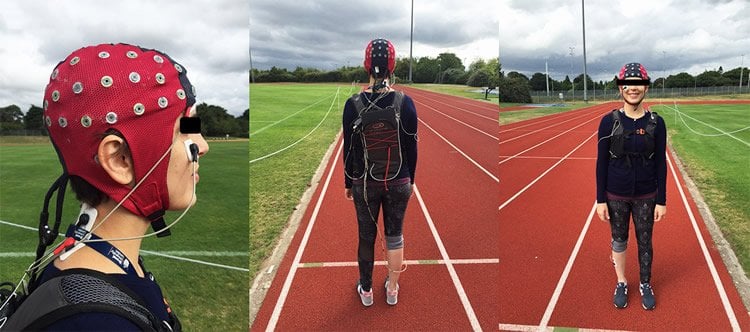Summary: Listening to music while exercising reduces focus, but boosts energy levels and enjoyment, researchers report.
Source: Brunel University.
Headphones are a standard sight in gyms and we’ve long known research shows listening to tunes can be a game-changer for your run or workout.
Back in 2012, Brunel University London’s Costas Karageorghis likened music to a legal, performance-enhancing drug, cheating tiredness and sparking feel-good vibes.
But the precise brain mechanisms music triggers during exercise are less understood. That’s because monitoring technology is easily tricked by body movements, so scientists couldn’t know if the results would be the same outside the lab.

Now researchers have used portable electroencephalogram (EEG) monitoring with interference shielding technology to measure three types of brainwaves during exercise. This lets them compare the brain’s electrical feedback while exercising outdoors to music, a podcast, or no soundtrack at all.
They found music rearranges the brain’s electrical frequency, causing a drop in focus but enhancing enjoyment 28% more than silence and 13% more than a podcast.
“The EEG technology facilitated measurement during an ecologically-valid outdoor task, so we could finally explore the brain mechanisms that underlie the effects of music during real-life exercise situations”, said Brunel psychophysiologist Marcelo Bigliassi.
Setting their own pace, 24 people walked 400m on an outdoor track to either a six-minute blast of Happy by Pharrell Williams, a TED Radio Hours talk about cities, or no sounds at all. Researchers used psychological scales to measure how good the walkers felt, what they focussed their attention on, how pepped or alert they felt and how tired they felt. Simultaneously they used EEG measurements and analysing software to plot their brainwaves across different band frequencies such as lower-alpha, upper-alpha, sensorimotor rhythm and beta.

Music distracted the walkers’ focus, but boosted their energy levels and enjoyment more than the TED podcast and not listening to anything. The podcast didn’t affect the walkers’ perceptual responses, such as how tired they felt, or their affective responses, such as how happy they felt. But it made them enjoy walking more than without a soundtrack. The study says the brain mechanisms behind these effects appear to be linked to a boost in beta frequencies in the frontal and frontal-central regions of the cortex.
“We showed that music has the potential to increase beta waves and elicit a more positive emotional state,” said Bigliassi. “This can be capitalised upon during other forms of exercise and render a given activity more pleasurable. People who struggle to engage in physical activity programmes should select appropriate pieces of music to exercise and see The Way It Makes You Feel.”
Source: Hayley Jarvis – Brunel University
Publisher: Organized by NeuroscienceNews.com.
Image Source: NeuroscienceNews.com images are credited to the researchers.
Original Research: Abstract for “Psychology of Sport and Exercise”.
DOI:10.1016/j.psychsport.2018.01.010
[cbtabs][cbtab title=”MLA”]Brunel University “Brainwaves Show How Exercising to Music Bends Your Mind.” NeuroscienceNews. NeuroscienceNews, 17 February 2018.
< https://neurosciencenews.com/exercise-music-8515/>.[/cbtab][cbtab title=”APA”]Brunel University (2018, February 17). Brainwaves Show How Exercising to Music Bends Your Mind. NeuroscienceNews. Retrieved February 17, 2018 from https://neurosciencenews.com/exercise-music-8515/[/cbtab][cbtab title=”Chicago”]Brunel University “Brainwaves Show How Exercising to Music Bends Your Mind.” https://neurosciencenews.com/exercise-music-8515/ (accessed February 17, 2018).[/cbtab][/cbtabs]
Abstract
The Way You Make Me Feel: Psychological and cerebral responses to music during real-life physical activity
Background
The brain mechanisms that underlie the psychological effects of auditory stimuli during physical activity are hitherto under-researched; particularly so in ecologically valid settings. The objective of the present experiment was to investigate the effects of two contrasting auditory stimuli conditions on psychological responses and brain activity during an outdoor walking task.
Methods
Twenty-four participants were required to walk 400 m at a pace of their choosing and report perceptual (state attention and perceived exertion) and affective (valence, arousal, and perceived enjoyment) outcomes immediately after each exercise bout. Three conditions were administered in a randomised and fully counterbalanced order (control, podcast, and music). State-of-the-art, portable EEG technology was used to facilitate measurement during the walking task. Fast Fourier Transform was used to decompose the brain’s electrical activity into different band waves (lower-alpha, upper-alpha, sensorimotor rhythm, and beta).
Results
The results indicated that music up-regulated beta waves, led to more dissociative thoughts, induced more positive affective responses, up-regulated arousal, and enhanced perceived enjoyment to a greater degree when compared to control and podcast.
Conclusions
Rearrangement of beta frequencies in the brain appears to elicit a more positive emotional state wherein participants are more likely to dissociate from internal sensory signals and focus on task-irrelevant factors. The portable EEG system used in the present study appears to accurately measure electrical activity in the brain during light-intensity physical activities and is effective in reducing electrical artefacts caused by body and cable movements.







